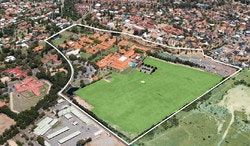Year 12 Human Biological Sciences 3AB
Overview
This course applies the basics taught in the Stage 2 Human Biological Sciences course. This course covers; Homeostasis, Endocrine System, Specific Resistance, Nervous Systems, Hormones, Skeleton, Muscles, Medical Technologies, Human life span, Cellular activities, DNA and RNA, Biotechnological techniques, Modes of inheritance and variation, Gene expression, Gene pools, Speciation, Primate and Hominin evolutionary trends,
Topics
Unit 3A:
The focus for this unit is human regulation. The body works to maintain a constant internal environment despite changes in the external environment. Normal body activities require constant feedback of blood sugar, temperature, gas and body fluid concentrations. Both the endocrine and nervous systems are involved in this maintenance. Malfunctions can be caused by genetics, behaviour or disease, and some can be controlled by medical intervention. Genes can be affected by the environment and/or chance events. The range of variation seen in humans today is not always the result of simple genetics and may involve more complicated models of inheritance. The environment can determine what lives or dies. This is a struggle for survival that has been recorded over millions of years in fossils. Natural selection leading to evolution is supported by evidence from comparative anatomy and biochemical studies. Throughout a human's lifetime there are medical treatments and procedures that can influence the quality of life.
Unit 2B:
The focus for this unit is the future of humans. Movement of the body requires complex processes of coordination. Bones, muscles and nerves must work together in a perfectly coordinated effort regardless of whether it is pulling a hand away from a hot object, playing sport or maintaining an upright stance. The malfunction of these systems can occur through trauma, disease and/or ageing. The role of DNA is vitally important and recent advances in knowledge and biotechniques have led to new ways of diagnosing and treating disease. If the body becomes damaged or infected, modern medical technology can be used to enhance trauma recovery, to deal with specific pathogens or alleviate the impact of ageing. Humans can trace their origins back for millions of years to the first primates. Throughout history there are a number of trends that can be followed through primates and hominins to the features of modern humans.
Assessments
Five end of topic tests: 30% | Four Practical Assessments (Investigations): 20% | Two Extended Response Assignments: 20% | Two end-of-semester examinations combined: 30%
Reporting
A brief interim report on class work and behaviour will be issued towards the end of Term 1. The achievement for each unit will be reported as a College A - E grade as well as a percentage mark for the unit and an examination mark. In addition, the student's approach to class work and behaviour will be reported via the usual key performance indicators.
Student Expectations - Homework
Homework marks contribute to the final score and form an important means of making a formative assessment of student understanding. In order to give timely feedback, the homework's will be marked and returned within 2-3 lessons. For this reason, students are to meet the deadlines as late submissions will be marked down severely.
